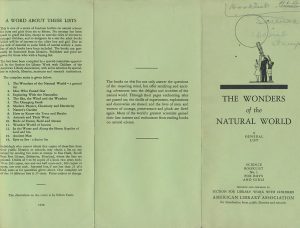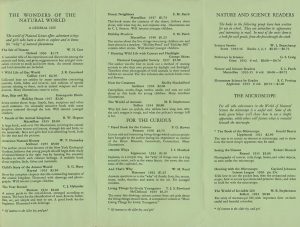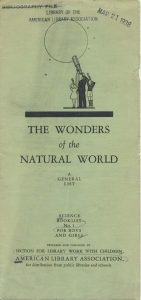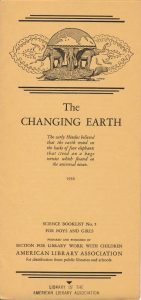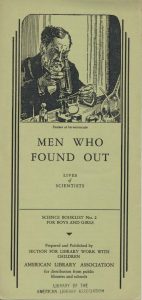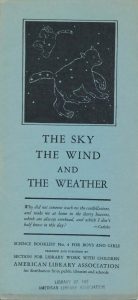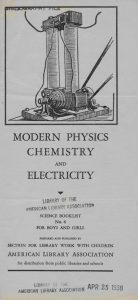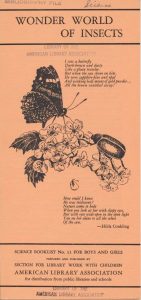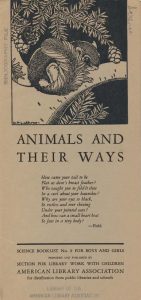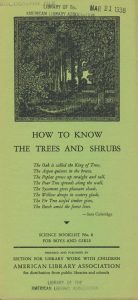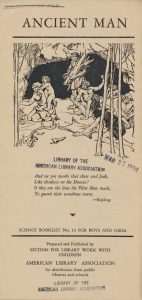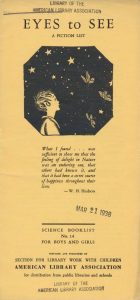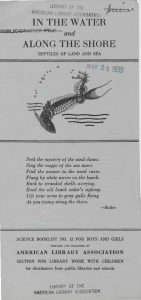Eighty years ago, in 1938, a Booklist series was produced to support interest in science among children. Published and prepared by the Section for Library Work with Children (later Division of Libraries for Children and Young People; now Association for Library Service to Children), the series highlighted recent publications about science while including delightful images and literary quotes to inspire readers.
All fourteen issues can be found in Record Series 24/3/2. In fact, with a little archives and library research, some readers might be delighted to know about the artists who were involved with this series too.
Read on to learn about the 1938 Science Booklist for Boys and Girls!
At first glance, researchers can see that all fourteen issues feature the same layout. Beyond the cover image, there is an even a forward about the list series with a note about the illustration’s creator, followed by a three-section list of book titles sorted by book author, with descriptions and prices of each title. The first issue, “The Wonders of the Natural World” is included below.
According to the publication’s notes, these book lists were printed at Baltimore’s Enoch Pratt Free Library, and they were sold at the price of two cents each (or less for orders greater than fifty). Found across the nation, these stylish pamphlets prominently feature images produced by at least eight different artists, and having artwork featured on library publications (found across the country) might have been thrilling for some artists too.
*Research tip: Although easy to disregard, ephemeral publications like short bibliographic pamphlets can help researchers know about historical experiences too. For example, these publications provide readers with information about what kinds of science and technology books might have been available to children in American libraries in the 1930s. The type of images and quotes excerpted for the pamphlet also provide us clues about what contemporary art might have been like.
Number 1 and Number 5 feature images made by Edwin Tunis. During the 1950s through 1970s, Mr. Tunis published many children’s titles, and in 1962 he was awarded a Newbery Medal Honor, for his book Frontier Living. [1]
*Research tip: Although not all ephemera contains detailed citations, when included, that bibliographic information may sometimes be the only available information on a person, publication, or publisher.
Number 2 and Number 4 feature unattributed images by Margery Stocking for the featured publication “The Story of Earth and Sky” by Carleton and Heluiz Washburne.
* Research tip: Always double-check citations against the source material. In the case above, the author had to physically locate copies of the books to confirm the illustrator’s identity and to identify Heluiz Washburne as a co-author.
Number 6 features an image from “A First Electrical Book for Boys” by electrical engineer and children’s book author Alfred Morgan. Mr. Morgan was also the illustrator for the book.
* Research tip: Although book authors are often cited, not all ephemera attributes the identity of illustrators, even when the illustrator is also the author.
Number 7, Number 10, and Number 11 feature images with unidentified artists from Oxford University Press. While more information on the artists has not been identified yet, notably, two covers include poetry. Number 10 includes a couplet from English poet Thomas Carew’s poem “The Spring” (1640), while Number 11 includes a poem from ten-year-old American poetess Hilda Conkling’s “The Butterfly Adventure” (1923).
*Research tip: When performing bibliographic research, be sure to confirm that you have the correct edition identified. You might be surprised how often libraries and archives are contacted to help identify incomplete citations which do not even provide a date or decade to help locate items.
Number 9 features a cut by American writer and illustrator Dorothy P. Lathrop, who was also earlier awarded a Newbery Medal Honor in 1932. [2] Another two years earlier, she was also the illustrator for Rachel Field’s 1930 Newbery Medal winning Hitty, Her First Hundred Years. Speaking of American novelist, poet, and writer Rachel Field, Number 9 also features a poem from her 1934 poetry collection Branches Green. [3]
Number 8 features a cut from Walter de la Mare’s 1923 poetry collection Come Hither, and the image accompanies an excerpt from English author, poet, and translator Sara Coleridge’s poem “Trees”. [4] [5]
Number 13 features a cut from the 1922 publication Everyday Life in the Old Stone Age by English author, historian, illustrator, and museum curator, Marjorie Quennell, and it is accompanied by a quote from fellow English author Rudyard Kipling’s 1906 book Puck of Pook’s Hill. [6]
Number 14 features a cut from American novelist and poet Mary Britton Miller’s 1928 poetry collection Menagerie and it is accompanied by a quote from Argentine author, naturalist, and ornithologist William Henry Hudson’s Far Away and Long Ago–An Autobiography of His Youth. [7]
Finally, Number 12 features a cut from American author and editor Irmengarde Eberle’s 1937 publication Sea-Horse Adventure illustrated by German-born American artist Else Winkler von Röder (Roeder) Bostelmann, and it is accompanied by an unidentified poem attributed to the English poet and satirist Samuel Butler. [8]
*Research tip: Incomplete citations can sabotage future bibliographic research because future researchers may not be able to identify the source. In the case of the poem, even eighty years later, it is not necessarily fast or easy to identify the works of a prolific seventeenth century writer. Always practice detailed bibliographic citations in everything you do–your future colleagues will thank you.
After reading, archival researching, bibliographical researching, and rereading of just twelve publications and their illustrations from 1938, the deeper history of a great many authors and illustrators (many of whom include women) the potential long-term information value of saving historic ephemera becomes evident. Before you throw those fliers or pamphlets away, think twice and contact your archivist. You never know who will be glad that you did.
Copies Available at Your ALA Archives
Physical copies of the Science Booklist for Boys and Girls publications are available for viewing at the ALA Archives. Please view the Record Series 24/3/2 database record entry, for more information too.
Got Something to Donate to the Story So Far?
Do you have information about a historic ALA publication which more of us should know about? Let us know through email, phone, or social media. We and our readers would love to read about it.
References
Other archives and manuscript libraries help preserve the stories of authors and illustrators too.
[1] The Edwin Tunis papers can be found at the University of Oregon Libraries’ Special Collections and University Archives.
[2] The Dorothy and Gertrude Lathrop Collection can be found at the Albany Institute of History and Art.
[3] The Papers of Rachel Field, 1845-1942 can be found at the Arthur and Elizabeth Schlesinger Library on the History of Women in America, Radcliffe Institute for Advanced Study, of Harvard University; also the Rachel Field Papers are at the Henry Madden Library, California State University, Fresno; and the Rachel Field Collection is at the Beinecke Rare Book and Manuscript Library of Yale University.
[4] The Papers of Walter de la Mare can be found at Edinburgh University Library Special Collections; while Walter de la Mare Collection of Papers are at the New York Public Library; and the Walter de la Mare Correspondence are at the Florida State University Special Collections and Archives.
[5] The Sara Coleridge Collection can be found at the Harry Ransom Center of the University of Texas at Austin.
[6] The Kipling Archive can be found at the University of Sussex Special Collections; while the Rudyard Kipling collection of papers can be found at the Henry W. and Albert A. Berg Collection of English and American Literature of the New York Public Library.
[7] The Mary Britton Miller Papers can be found at the Manuscripts and Archives Division of the New York Public Library.
[8] The Irmengard Eberle Papers can be found at the University of Oregon Libraries Special Collections and University Archives; while the Irmengard Eberle Papers are also found at the University of Southern Mississippi University Libraries McCain Library and Archives.
